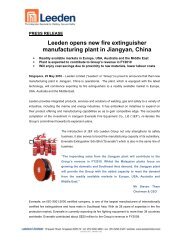Annual Report 2010 - Leeden Limited
Annual Report 2010 - Leeden Limited
Annual Report 2010 - Leeden Limited
You also want an ePaper? Increase the reach of your titles
YUMPU automatically turns print PDFs into web optimized ePapers that Google loves.
Notes to the Financial Statementsfor the Financial Year ended 31 December <strong>2010</strong><strong>Leeden</strong> <strong>Limited</strong> <strong>Annual</strong> <strong>Report</strong> <strong>2010</strong>2. Summary of significant accounting policies (cont’d)2.14 Impairment of financial assets (cont’d)(c)Available-for-sale financial assetsIn the case of equity investments classified as available-for-sale, objective evidence of impairment include (i)significant financial difficulty of the issuer or obligor, (ii) information about significant changes with an adverse effectthat have taken place in the technological, market, economic or legal environment in which the issuer operates,and indicates that the cost of the investment in equity instrument may not be recovered; and (iii) a significant orprolonged decline in the fair value of the investment below its costs. Significant’ is to be evaluated against theoriginal cost of the investment and ‘prolonged’ against the period in which the fair value has been below its originalcost.Significant or prolonged decline in fair value below cost, significant financial difficulties of the issuer or obligor, andthe disappearance of an active trading market are considerations to determine whether there is objective evidencethat investment securities classified as available-for-sale financial assets are impaired.If an available-for-sale financial asset is impaired, an amount comprising the difference between its cost (net of anyprincipal payment and amortisation) and its current fair value, less any impairment loss previously recognised inprofit or loss, increase in their fair value after impairment are recognised directly in other comprehensive income.In the case of debt instruments classified as available-for-sale, impairment is assessed based on the same criteriaas financial assets carried at amortised cost. However, the amount recorded for impairment is the cumulative lossmeasured as the difference between the amortised cost and the current fair value, less any impairment loss onthat investment previously recognised in profit or loss. Future interest income continues to be accrued based onthe reduced carrying amount of the asset and is accrued using the rate of interest used to discount the future cashflows for the purpose of measuring the impairment loss. The interest income is recorded as part of finance income.If, in a subsequent year, the fair value of a debt instrument increases and the increases can be objectively relatedto an event occurring after the impairment loss was recognised in profit or loss, the impairment loss is reversed inprofit or loss.2.15 Development propertyDevelopment properties are properties held and developed for sale in the ordinary course of business. Developmentproperties are stated at the lower of cost and net realisable value. The costs are assigned by using specific identification.Net realisable value represents the estimated selling price less costs to be incurred in selling the property.Costs of properties under development include land acquisition costs, development expenditure, borrowing costs andother related expenditure. Borrowing costs payable on loans funding a development property are capitalised as cost ofthe development property until the date of its practical completion, which is taken to be the date of issue of the TemporaryOccupation Permit (“TOP”).Revenue and costs associated with the development property are recognised as revenue and expenses respectively, byreference to the stage of completion of the development property at the balance sheet date, when the outcome of theconstruction contract can be estimated reliably. The stage of completion is determined by reference to the proportion thatcontract costs incurred for work performed to date bear to the total estimated contract costs, costs in both cases excludeland and interest costs. When the outcome of a construction contract cannot be estimated reliably, revenue is recognisedto the extent of costs incurred that are likely to be recoverable and development costs are recognised as expense in theperiod which they are incurred.When it is probable that total development costs will exceed total revenue of the construction contract, provision forexpected loss is recognised as an expense immediately. Revenue of the construction contract comprise the amount ofrevenue agreed in the contract.The development property will be transferred to development property completed for sale when it has been completed, theTOP has been obtained and it is available for sale.57





